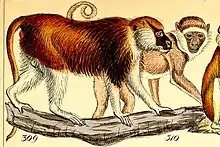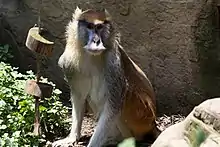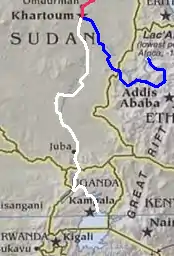Blue Nile patas monkey
The Blue Nile patas monkey (Erythrocebus poliophaeus) is a species of Old World monkey found in Africa along the Blue Nile river valley. It is known from Ethiopia and Sudan, and may be threatened by habitat loss. While first described in 1862, it was synonymized with the patas monkey in 1927. A reclassification in 2018 confirmed its status as a distinct species. It can be easily distinguished from the common patas monkey by the distinctive hair on its face, which resembles a handlebar moustache.[1][2][3]
| Blue Nile patas monkey | |
|---|---|
 | |
| Scientific classification | |
| Kingdom: | Animalia |
| Phylum: | Chordata |
| Class: | Mammalia |
| Order: | Primates |
| Suborder: | Haplorhini |
| Infraorder: | Simiiformes |
| Family: | Cercopithecidae |
| Genus: | Erythrocebus |
| Species: | E. poliophaeus |
| Binomial name | |
| Erythrocebus poliophaeus Reichenbach, 1862 | |
Taxonomy
Classification of the Blue Nile patas monkey has been widely debated for years, with previous taxonomic decisions being based only on a single specimen which did not come with extensive background knowledge.[3] The first widely adopted taxonomy was created by Schwartz through his research in 1927.[3] The Erythrocebus monkeys were classified into three subspecies: patas, pyrrhonotus and baumstarki, creating and overall monotypic genus.[3]
Erythrocebus species were classified by their nose colour and this created gaps in their classification.[4] Around 1974, it was noticed that nose colour could actually change due to age or physiology, but this only created further confusion within the research community and the previous classification was left unchanged. In 2018, E. poliophaeus was resurrected as a separate species based on a number of distinct physiological characteristics.[3]
Description
Blue Nile Patas monkeys are medium in size but have distinctly long limbs in comparison with other monkeys of a similar size. They possess a long tail which arches behind them as they walk. Their tails are not prehensile, which is characteristic of all Old World Monkeys.[4] Their feet are long and padded.[4] These structures make them a fast-paced monkey, equipped for efficient long distance travel. They have a slender frame, consisting of a deep chest which curves down at the torso.[4]
Their coat and pelage vary across individuals and age group. It is mainly wiry and reddish in nature, with the lower half of the face and inner limbs being a lighter brown or white colour and a blackish grey along their upper limbs.[5] This distinction between the under and upper sides of their body is most prominent in males.[5] The crown of the head is a deep reddish-brown colour, which turns grey with age.[5] This species of patas monkey is most famously known for their white upper lip hair which forms the shape of a handlebar moustache.[4]
Their weight ranges from 7 to 13 kilograms, with adult males being double the size of adult females.[4] Similar to this weight difference, males have canine teeth about twice the size of females, showing many characteristics of sexual dimorphism. Females tend to have a less distinctive arch in their tails as well.[5]

Blue Nile Patas monkeys have binocular vision, with their eyes facing straight forward.[5] Their nostrils are quite narrow and tilt downwards in a catarrhine formation.[3] In terms of dental formula; their molars are bilophodont, incisors spatulate with conspicuous canines.[4]
Distribution and habitat

The Blue Nile Patas monkey prefers savannah or woodland type habitats over dense vegetation or forests as their fastest form of transport is running on land.[6] Although they prefer open land for travelling, they seek out areas of tall trees to sleep in for safety from predators at night.[6]
Patas monkeys do not stray far from water sources and as their name suggest typically can be found along the Blue Nile River.[7] This river flows across Ethiopia and Sudan, with monkeys from these areas being found as far south as Tanzania and far west as Senegal and Kenya.[6] These areas of Africa range from the borders of the Sahara Desert to tropical equatorial conditions, making E. poliophaeus a highly adaptive and resilient monkey.[6]
The E. poliophaeus species is able to be physically distinguished from other species in the genus through their geographical distribution.[7] They reside along the western areas of Ethiopia and Sudan which is separated by the Ethiopian highlands and Sudan’s swampy region.[6] This is also one of the key reasons that the E. poliophaeus needed to be separated from the E. patas subspecies.[6]
Behaviour
Young Patas monkeys, typically three to twelve months in age, spend the majority of their time playing.[4] Activities such as play-wrestling and chasing other juveniles allows them to build key social skills that they will require as adults.[5] Most of these play behaviours occur on the ground where Patas monkeys are most comfortable.[7] Young monkeys learn to groom each other early and this is a common behaviour amongst both juveniles and adults.[7]
Adult male Patas monkeys are the watch guards of their family.[7] They observe predators from the tops of trees and have a noisy bouncing display that they perform when disturbed, to dissuade attacks and intrusion.[7] Males tend to separate from the group when they are not resting, grooming or mating. Female adult Patas monkeys lead the family and initiate any movement that needs to occur.[6] They are the primary caretakers of the young.[6] Any physical defence against threats are mainly made by the females of the family. It is rare for a male to be involved in this and females usually attack in groups of three.[7]
Patas monkeys are very fast and can silently travel distances at a high speed.[7] When threatened, smaller or more vulnerable monkeys tend to resort to quickly fleeing.[7] Males also possess a contralto bark which they utter repeatedly when encountered by another group of Patas monkeys.[7]
Conservation
The Blue Nile Patas monkey was originally an abundant species in Kenya, but studies from 2000 onwards showed a lack of their distribution in this part of Africa.[1] It was discovered the growing human population in Kenya around this time may have been the cause.[8] Farmers were converted the dry areas inhabited by the monkeys into farmland, thus decreasing their numbers in this region. Crop raiding was also a key cause in their lack of abundance.[8]
Research showed that Patas monkeys also positively affected by human modifications to their environment, as shown by their use of on man-made water sources in Kenya.[8] Combined with a reduction in numbers of their non-human predator population drove their numbers up and allow them to co-exist on the land with humans.[8]
References
- Rincon, Paul (2018). "Moustached monkey is separate species". BBC News. Retrieved 2018-03-19.
- "150 years after being discovered, African monkey with handlebar moustache becomes its own species". news.mongabay.com. 16 March 2018. Retrieved 2018-03-19.
- Gippoliti, Spartaco (2017). "On the Taxonomy of Erythrocebus with a Re-evaluation of Erythrocebus poliophaeus (Reichenbach, 1862) from the Blue Nile Region of Sudan and Ethiopia" (PDF). Primate Conservation. 31: 53–59. ISSN 2162-4232. Retrieved 17 January 2018.
- Autin, Beth. "LibGuides: Patas Monkey (Erythrocebus patas) Fact Sheet: Physical Characteristics". ielc.libguides.com. Retrieved 2020-05-28.
- "Signing into eresources, The University of Sydney Library". login.ezproxy2.library.usyd.edu.au. Retrieved 2020-05-28.
- Macdonald, David Whyte; Press, Oxford University (2006). Encyclopedia of mammals (New ed.). Oxford : Oxford University Press. ISBN 978-0-19-920608-7.
- Hall, K. R. L. (1966). "Behaviour and ecology of the wild Patas monkey, Erythrocebus patas, in Uganda". Journal of Zoology. 148 (1): 15–87. doi:10.1111/j.1469-7998.1966.tb02942.x. ISSN 1469-7998.
- de Jong, Yvonne; Butynski, Thomas; Anne-Isola, K; Nekaris, K. Anne (2008-01-01). "Distribution and Conservation Of the Patas Monkey Erythrocebus patas In Kenya". Journal of East African Natural History. 97: 83–102. doi:10.2982/0012-8317(2008)97[83:DACOTP]2.0.CO;2.